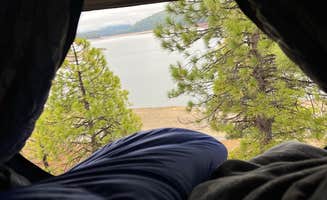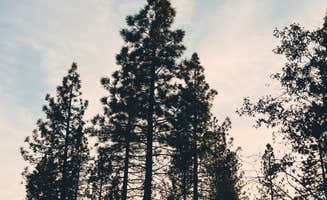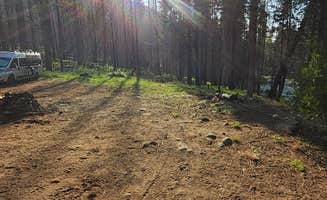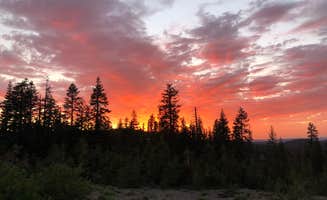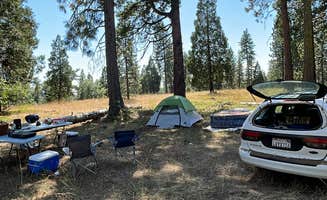Primitive camping near El Dorado Hills, California concentrates in the Eldorado National Forest at elevations ranging from 5,000 to 7,500 feet. Most dispersed sites require travel on unpaved forest roads, with access typically limited to May through October due to snow conditions. Winter camping requires additional permits and preparation for subfreezing temperatures that commonly drop below 20°F at higher elevations.
What to do
Water activities at Union Valley Reservoir: This large reservoir offers swimming and fishing opportunities during summer months when water temperatures rise. "The lake is really warm in the summer," notes reviewer Kristen M., making it ideal for cooling off during hot weather excursions from Union Valley Reservoir Dispersed Camping.
Winter exploration: While snow limits vehicle access to many sites, some lower elevation areas remain accessible for cold-weather camping. "Pulled off Union valley road and set up camp with our Rooftop tent. Little cold up here in November but made for some great pre-snowfall camping," shares Nick M. about his late-season adventure.
Hiking abandoned infrastructure: The old ski resort at Iron Mountain provides unique exploration opportunities among defunct equipment. "The abandoned ski lifts are pretty cool to look at and hike along them as well," explains Alicia, who recommends camping "as far from the highway as possible" to minimize road noise.
What campers like
Sunset viewing: Multiple campers highlight exceptional sunset viewing from elevated sites. "At 7500 feet above sea level, the view is wide and the scenery is beautiful, especially the sunset view," writes Leo Y. about his experience at Iron MT. Dispersed. Another camper notes that sunset colors can last for "a good two hour" period due to the elevated perspective.
Between-season solitude: Visiting during shoulder seasons often means having entire areas to yourself. "Not too many people in between seasons. Summer time is not bad," reports Verna T. about Union Valley Reservoir. Mid-week visits further increase chances for privacy at most locations.
River access: Sites along Silver Fork River provide direct water access. "All the sites are on the river and have paths down to the water with a little beach," describes a reviewer at Silver Fork River Camping, noting that "it's a popular fishing spot with the locals" despite cold water temperatures into early summer.
What you should know
Road conditions vary significantly: Forest roads range from well-maintained to challenging. Alex from USFS Silver Fork Dispersed explains: "Despite being primitive, the roads are well kept, even if you have a small SUV. It could get slightly tricky with a car." Allow extra time and bring appropriate vehicles.
Winter access restrictions: Snow closes most areas for extended periods. "The site was covered in snow, and there was a sign saying no camping in snow clearing conditions. Additionally you aren't allowed in without a Sno-park permit from November 1st to May 31st," cautions Ted T.
Fire regulations change seasonally: Current fire restrictions must be checked before each visit. Raymond M. advises: "Be sure to obtain a fire permit from Cal Fire and check fire restrictions in the area have a bucket full of water and a shovel next to your fire at all times."
Cell service limitations: Coverage varies by location and carrier. "At the above coordinates, there were 2 bars of low grade coverage allowing basic texts to send. Not enough service for web browsing or sending photos via text," reports Alex about AT&T coverage at their Silver Fork campsite.
Tips for camping with families
Scout sites before setting up: Many areas have multiple potential spots with varying terrain. "We recommend taking some time to survey the land before setting up camp, as some spots are slightly sloped," advises Raymond B. about Mormon Emigrant Trail Dispersed Pull Off.
Arrive before dark: Finding unmarked sites becomes significantly more difficult after sunset. "Showed up to pinned spot around 3pm and saw zero people... There were multiple spots off to the side where ppl had previously parked/camped w/ fire pits," reports Callie C., highlighting the importance of daylight arrival for site selection.
Plan for complete self-sufficiency: No services exist at dispersed sites. Orion B. shares this practical advice: "We brought a privacy shelter and portable camp toilet, and our own water. Those are really the only things you need that would normally be provided by a paid campsite."
Tips from RVers
Flat surfaces at abandoned sites: Former developed areas provide unusually level parking for larger vehicles. "The ground is very flat and many areas are paved with gravel," notes Leo Y. about Lake Valley Rd Pullout, making it suitable for RVs requiring more stable positioning.
Seasonal road closures for larger vehicles: Winter conditions make most forest roads impassable. "Got stuck for over a day trying to get to the site. Tow truck also got stuck. Would not recommend coming until spring," warns William J. about winter access attempts.
Multiple site options for various vehicle sizes: Many areas offer progressively more remote sites based on vehicle capability. "The 3rd site requires a vehicle with a little more clearance. We got our group to the second site and that included a van camper that was 2wd so it's easy to get to the first two sites," explains a reviewer about Silver Fork River sites.


